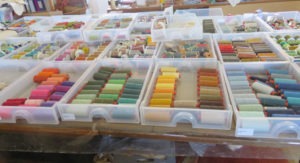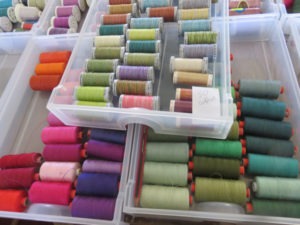Threads

I started the year with a bang by going to summer school in Bathurst run by Fibre Arts Australia to do a workshop with Dionne Swift. After an amazing informative and instructive workshop I came home thinking a lot about threads. There is so much to learn about threads. There is so much variety and colours to choose from. After I got home I had to face the task of unpacking my threads and putting them back in their drawers. So how best to organise them? I used to organise by brand and colour. After the workshop I rethought my approach and decided to organise by weight and then colour. It took me all day to sort it all out. I also found that I favoured blues, greens, earthy colours. In the process I could all see the gaps in my thread collection.
Looking at thread weight can be confusing and frustrating as there really is no standard system in place. There are different systems in place. The weight standard is one that many quilters and textile people understand. The higher the number the finer the thread. The lower the number the thicker the thread. As well the number refers to how many metres of thread to one gram e.g. 40 metres of 40wt weighs gram whilst 12 metres of 12wt weighs 1 gram. Simple and easy to understand. Apparently the Tex system was supposedly developed to standardise the industry. In this system the higher the number the thicker the thread. So whilst sorting my threads I found my Rasant threads were using the Tex system and all my other threads were using the weight standard. I rang a few suppliers trying to work out what these threads could be equivalent to in the weight standard. I was told that everyone uses the Tex system what am I on about. Well I still don’t know whether the Rasant’s are equivalent to a 40wt or 50wt. I’m totally confused.
Then the other consideration is how the thread is wound and plied. Threads may be single ply or 2 or 3 ply. How it is wound is important as that dictates how it comes off the spool. So stacked threads need to be upright on the spool holder and the cross hatched threads need to be horizontal on the spool holder. When I have had them wrong I can have thread problems whilst sewing.
There is so much more to learn about threads. I went through my information folders and pulled all thread info out and put it together to keep with my threads so that I had a quick reference when I needed it. I also have much more to think about as I stitch either by machine or hand on my art work.


I still don’t know whether the Rasant’s are equivalent to a 40wt or 50wt.
50wt thread is like a thin bobbin thread for machine embroidery. 100wt is very fine – a doddle to thread, but a pain to remove as it is hard to see.
So if your Rasant is more like an ordinary hand sewing thread… it must be TEX.